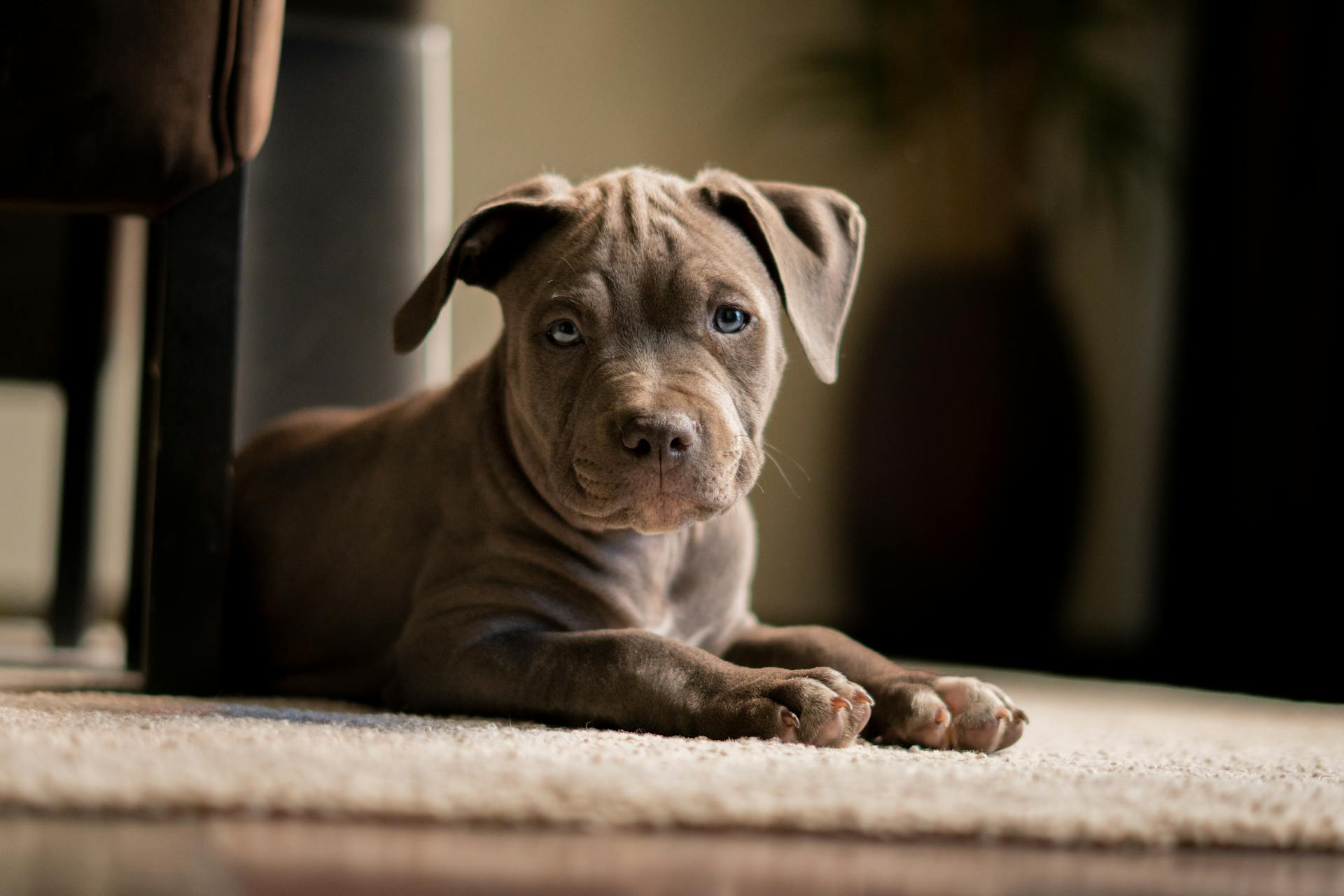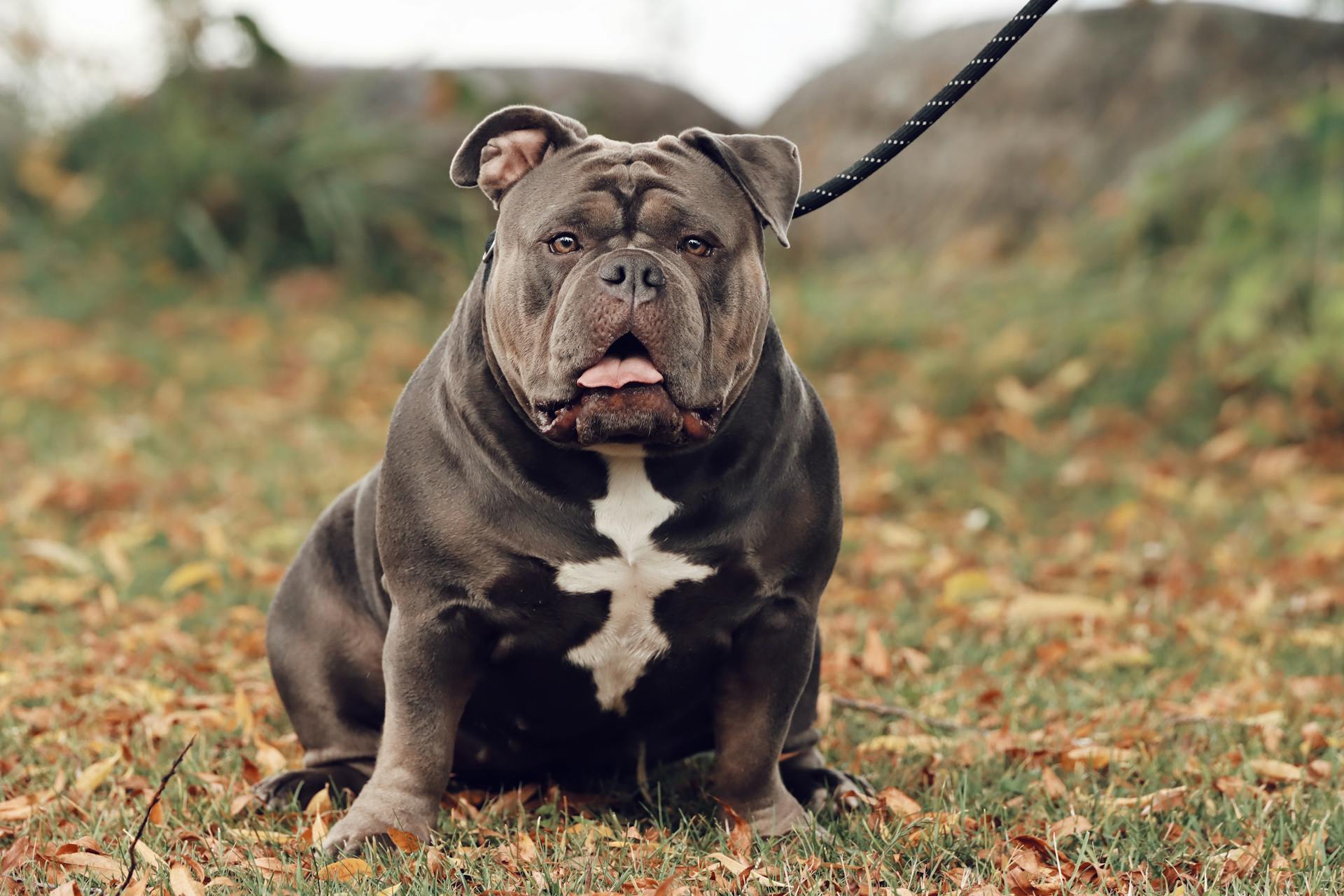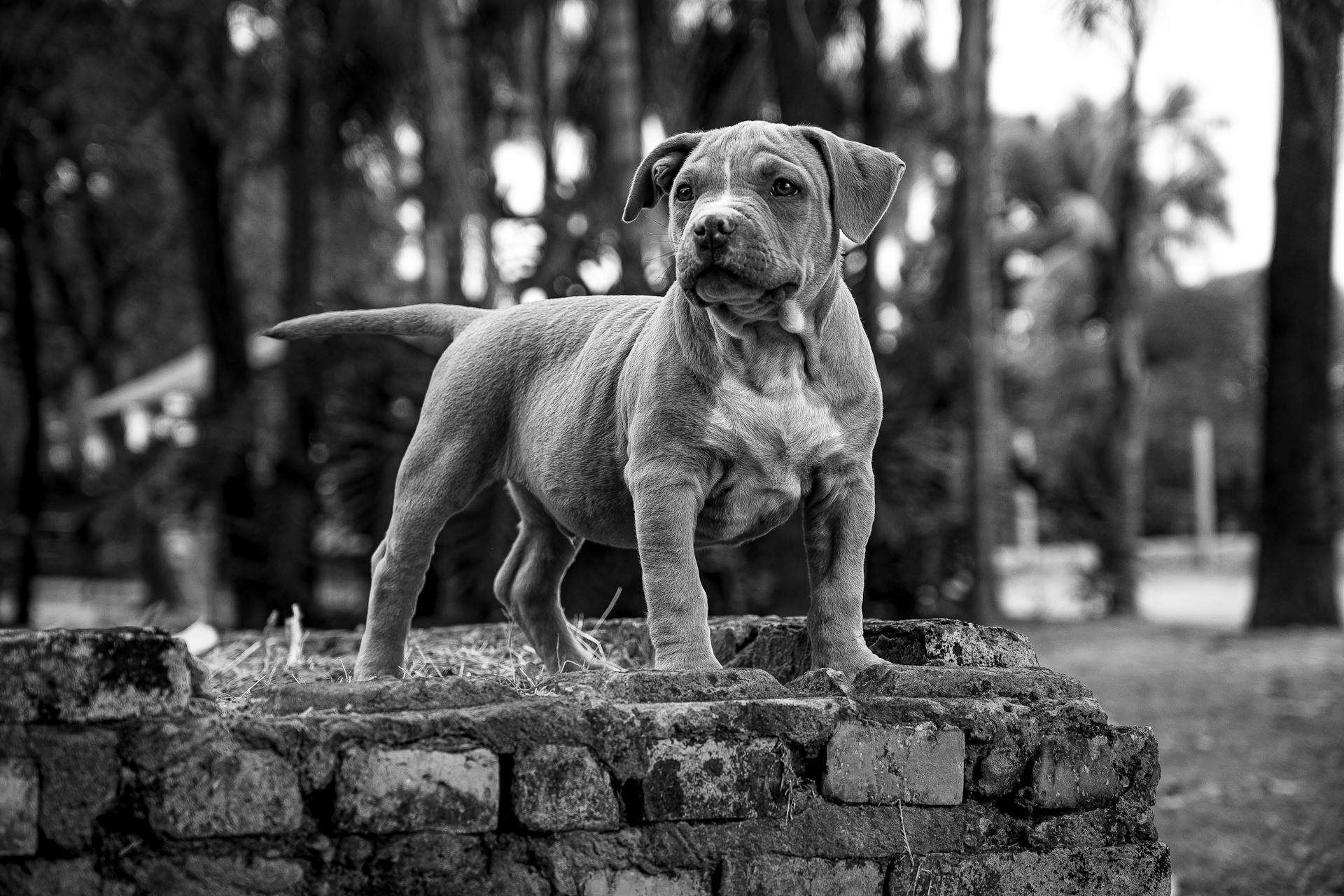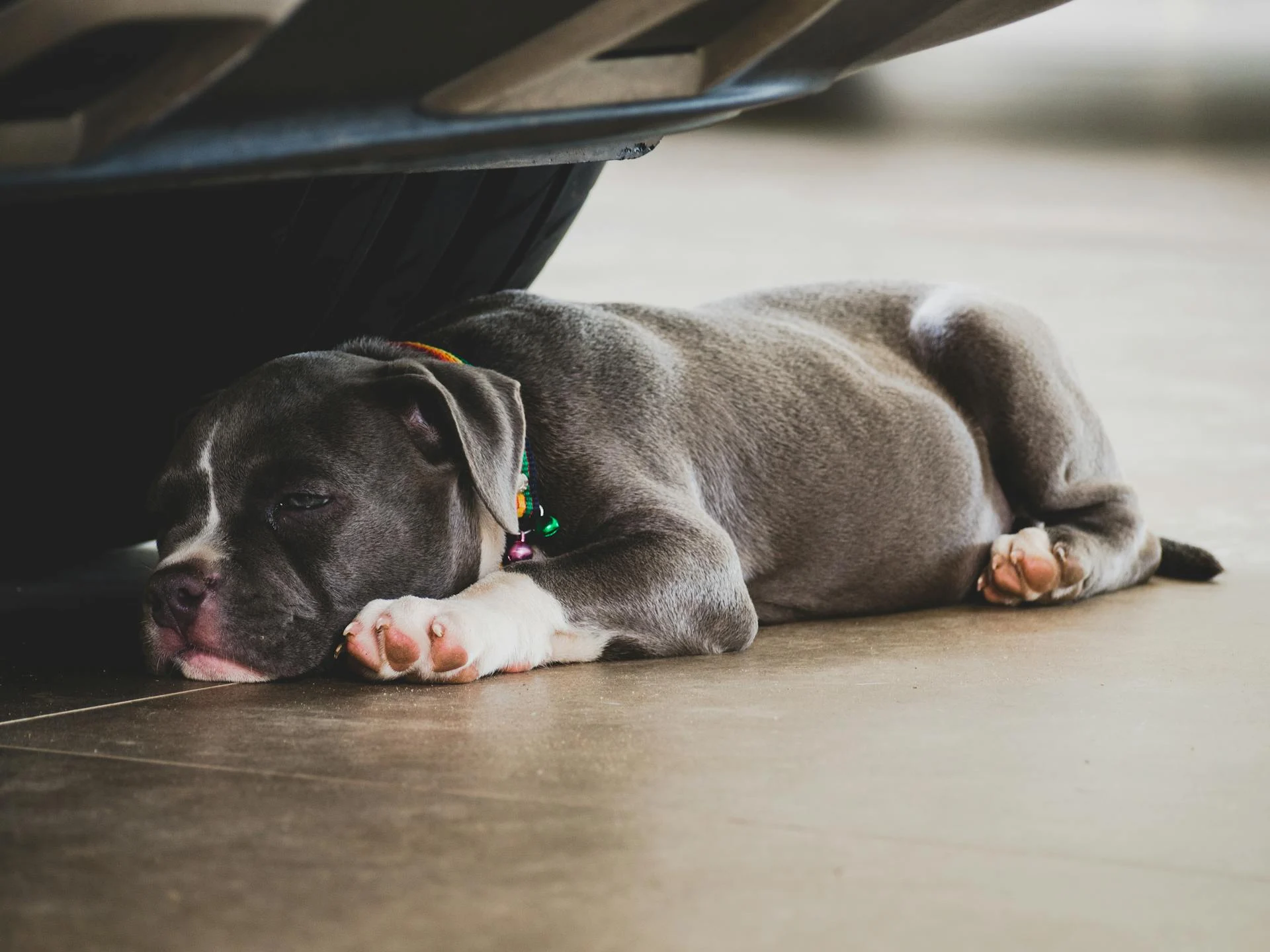
Choosing the right American Bully breed can be a daunting task, especially with the two popular varieties: Pocket Bully and XL Bully.
The Pocket Bully is a compact and muscular dog, weighing between 40-55 pounds and standing 13-17 inches tall.
In contrast, the XL Bully is a larger and more massive dog, weighing between 70-120 pounds and standing 17-20 inches tall.
If you're looking for a dog that's easy to handle and requires less exercise, the Pocket Bully might be the perfect fit.
Breed Characteristics
Pocket Bullies are generally more agile and have a higher energy level than XL Bullies. They require regular exercise to maintain their physical and mental health.
One key characteristic of Pocket Bullies is their smaller size, typically weighing between 40-55 pounds. This makes them a great choice for families with smaller living spaces.
XL Bullies, on the other hand, are larger and more laid-back, weighing between 70-120 pounds. Their calm demeanor makes them a great companion for those who want a low-maintenance pet.
Pocket Bullies are often described as " Velcro dogs" due to their strong attachment to their owners. They thrive on attention and interaction.
XL Bullies, while still loyal and loving, tend to be more independent and don't require as much attention as Pocket Bullies.
Health and Care
As you consider bringing a Pocket Bully or XL Bully into your family, it's essential to think about their health and care needs. Both breeds can be prone to certain health issues, so regular check-ups are a must.
Their short stature makes them more susceptible to heat stress, especially in hot regions, so keep them cool and comfortable. This is especially true for Micro Bullies, who are more likely to suffer from heat stress due to their small size.
Some common health conditions that can affect both breeds include joint problems, heart disease, and hip dysplasia. These conditions can be managed with proper care and attention, but it's crucial to catch them early.
While regular exercise is essential for any dog, it's especially important for Bullies, who can be prone to obesity. A balanced diet and regular check-ups with your veterinarian can help prevent weight gain and related health issues.
Here are some common health conditions that can affect Bullies:
- Hip Dysplasia
- Hypothyroidism
- Neuronal Ceroid Lipofuscinosis
- Elbow Dysplasia
- Heart Disease
- Cataracts
- Dermatitis
- Cleft Palate or Lip
- Cerebellar Abiotrophy
- Ichthyosis
- Patellar Luxation
By understanding these potential health issues and taking steps to prevent them, you can help your Pocket Bully or XL Bully live a long, happy, and healthy life.
History and Origin
The Pocket Bully was bred to combine the best qualities of an American pit bull terrier and a Patterdale terrier.
This breed was developed to provide a wonderful family companion that doesn't need a lot of exercise. Its strong bones and bulky appearance make it a popular choice.
Many dog owners in America with mixed dog breeds eventually gave rise to the American Bully, making it a popular dog breed up to this day.
Readers also liked: Boxer Bully Breed
Breed History
The Pocket Bully was bred to combine the best qualities of an American pit bull terrier and a Patterdale terrier.
This breed was developed to provide a wonderful family companion that doesn't need a lot of exercise.
The American Bully Kennel Club, or ABKC, notes that the Pocket Bully was bred to have strong bones and a bulky appearance.
Many dog owners in America with mixed dog breeds eventually gave rise to the American Bully, making them a popular dog breed to this day.
For more insights, see: Pocket Bully Breed
Historical Differences

The American Bully breed has a relatively recent history, developed between 1980 and 1990 in the United States.
It wasn't until 2004 that the American Bully was recognized as a breed by the American Bully Kennel Club (ABKC).
The Pocket Bully, on the other hand, is a mix between the American Bully and the Patterdale Terrier, but it's the American Bully traits that dominate.
This results in the Pocket Bully being often referred to as the mini version of the American Bully due to their strong similarity.
The Pocket Bully first appeared just over 20 years ago and has been gaining popularity ever since.
Check this out: How to Breed an American Bully
Physical Attributes
The Pocket Bully and XL Bully breeds are known for their impressive physical attributes, which set them apart from other dog breeds.
The Pocket Bully has a compact and muscular build, with a robust and well-defined physique that makes them lean and athletic. They have a low body fat percentage.
Expand your knowledge: What Are Bully Breeds
Their heads are thick and wide, with a short, wide nose and powerful jaw. This distinctive feature is a hallmark of the Pocket Bully breed.
In contrast, the XL Bully has a more broad and muscular build, with larger heads and shorter legs compared to the Pocket Bully. They typically weigh between 50 to 120 pounds and stand about 18 to 22 inches at the shoulders.
Information and Pictures
People often confuse the American Pit Bull Terrier with the American Bully Pit, but they are distinct breeds with clear differences.
The American Bully is a more muscular breed with a broader build, often featuring larger heads and shorter legs. One of the most noticeable differences is their weight and height.
American Pit Bulls typically weigh between 30 to 70 pounds and stand about 18 to 22 inches at the shoulders, while American Bullies can weigh between 50 to 120 pounds.
The goal of the American Bully breed is to be muscular and broad with a big head, which sets them apart from the American Pit Bull Terrier.
For another approach, see: Bully Pit Dog
Physical Attributes
The American Bully breed is known for its muscular build, with some dogs weighing up to 120 pounds. Pocket Bullies, a variation of the breed, are also robust and well-defined, with a low body fat percentage.
Their compact and muscular build makes them look athletic and lean, even if they're not as tall as other breeds. Pocket Bullies have short, stocky legs with well-defined muscles and a robust frame.
Their broad chests and shoulders give them a strong and powerful appearance, making them look like they could take on just about anything. The Micro Bully, a smaller version of the breed, is still stocky and muscular, but with a more compact build.
One of the defining features of the American Bully breed is their broad heads, which are often accompanied by a short, wide nose and powerful jaw. Pocket Bullies, in particular, are known for their big, broad heads.
In terms of size, American Bullies can weigh anywhere from 50 to 120 pounds, while Micro Bullies typically weigh between 25 and 35 pounds. Despite their size differences, both breeds have a similar chunky build and muscular physique.
See what others are reading: American Bully Xl Size
Care and Maintenance
When it comes to grooming, both the Pocket Bully and the XL Bully are relatively low maintenance breeds. They have low and sleek coats that don't require frequent grooming.
They don't shed much, but a bit of brushing will keep their coat looking shiny and healthy. I've noticed that regular brushing can also help prevent matting and tangling.
Their ears and nails may need occasional cleaning and trimming, and they'll likely need a bath if they've been playing outside.
Exercise Requirements
Exercise Requirements are crucial for your Micro Bully or Pocket Bully's overall health and happiness. A short walk and some playtime in the yard or at a dog park will keep your Micro Bully content and in shape.
Micro Bullies don't require hours of vigorous exercise, but they do like some form of activity on a regular basis. They're happy with a balance of relaxation and playtime.
Pocket Bullies are a bit more energetic, but they're still easy to please when it comes to exercise. A couple of walks in a day and a few minutes running around the house would be enough to keep them happy and healthy.
Here's a quick rundown of the exercise needs for both breeds:
- Micro Bully: Short walk and playtime in the yard or at a dog park
- Pocket Bully: Couple of walks in a day and a few minutes running around the house
Grooming
Grooming is a breeze for Micro and Pocket bullies, as they have low and sleek coats that require minimal effort to maintain.
Their coats are prone to minimal shedding, but a little brushing now and then will keep them looking shiny and healthy.
Occasional ear cleaning and nail trimming might be necessary to keep them in top condition.
Baths are only needed after they've been playing outside and gotten dirty.
Food Requirements
A Pocket Bully's diet is influenced by their size, which means they need less food than an American Bully.
A Pocket Bully only needs 2 cups of high-quality dog food daily.
Their food intake is also affected by their activities, such as intensive training or exercises, which can increase their food needs to build muscle mass.
If your Pocket Bully has a lot of physical activity, you may need to adjust their food intake accordingly.
At the end of the day, their food needs are all about finding the right balance to keep them healthy and happy.
Training and Behavior
Training and behavior are crucial aspects of owning a Pocket Bully or XL Bully. Both breeds require early socialization and training to avoid developing negative traits.
American Bullies and Pocket Bullies share similar training methods, with a focus on rewards-based commands. Rewarding your dog with treats and praise is an effective way to encourage good behavior.
Pocket Bullies, being more energetic, require more frequent engagement and exercise to drain their energy. A minimum of 5-10 minute training sessions per day is recommended.
To stimulate your Pocket Bully's mind and body, engage in activities that challenge them physically and mentally. This will help prevent boredom and destructive behavior.
Micro Bullies, a smaller breed, are known for their strong character and affectionate nature. They make great watchdogs when trained to be vigilant.
Temperament-wise, Micro Bullies are affectionate, playful, and obstinate, while Pocket Bullies are confident, loyal, and friendly, with a hint of stubbornness.
Here's a comparison of the two breeds:
YesLoyal
Yes
American Bullies are known for their fierce loyalty and goofy nature, making them great companions for families and children. Pocket Bullies, on the other hand, inherit traits from the Patterdale Terrier, resulting in boundless energy levels.
Standard, Classic, Micro & Exotic
The American Bully breed has a variety of classes, including Standard, Classic, Micro, and Exotic. The American Bully Kennel Club (ABKC) and United Kennel Club (UKC) recognize these classes.
The Standard Bully is a great choice for those who want a more traditional American Bully size. It's a good starting point if you're new to the breed.
Classic Bullies are similar to Standard Bullies but have a slightly different build. They're a popular choice among breeders and owners alike.
Micro Bullies are a variant of the American Bully breed, but they're not officially recognized by the ABKC or UKC. They're smaller than Pocket Bullies and can be prone to health issues like knee problems and overheating.
Exotic Bullies are not a recognized class by the ABKC or UKC, but rather a term used to describe unusual or rare color patterns.
Here's a comparison of the different classes:
Ultimately, the choice of class depends on your personal preferences and needs. If you're looking for a smaller American Bully, a Pocket Bully might be a good choice. If you want something bigger, a Standard Bully or XL Bully might be a better fit.
Size and Comparison
The size difference between Pocket Bullies and XL Bullies is quite remarkable. A Pocket Bully typically stands between 13 to 17 inches tall.
Their weight varies between 10 to 22 pounds, depending on the dog's gender. XL Bullies, on the other hand, can grow up to 23 inches tall for males and 22 inches for females.
Despite their height difference, XL Bullies share a similar muscular build with Standard Bullies. They are simply taller and have a bigger body mass. Pocket Bullies, as their name suggests, are much smaller and more compact.
Here's a comparison of the two breeds:
As you can see from the table, Pocket Bullies are generally smaller than XL Bullies. However, it's essential to remember that size and weight can vary depending on factors such as diet, exercise, and overall health.
Frequently Asked Questions
Are XL bullies the same as pocket bullies?
No, XL Bullies are a larger and more muscular variant of the American Bully breed, while Pocket Bullies are a smaller and more compact version. If you're interested in learning more about the differences between these breed types, check out our breed comparison guide
Sources
- https://www.dogbreedinfo.com/p/pitbullvsamericanbully.htm
- https://blog.tryfi.com/micro-bully-vs-pocket-bully/
- https://pitbulls.org/article/american-bully-vs-pocket-bully
- https://medium.com/texassizebullies/what-is-a-pocket-size-american-bully-micro-vs-pocket-standard-xl-the-exotic-bully-98d2c9a001a9
- https://pawsandpup.com/blogs/news/pocket-bully-owners-guide
Featured Images: pexels.com


